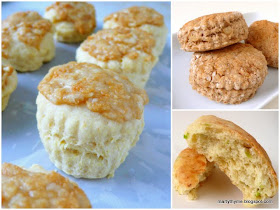 |
| SCONES 3 WAYS: (clockwise from left) cheese and mustard; ginger-spelt; and Cheddar-scallion |
I hadn't even put down my bag when I turned on the oven to heat it up for the biscuits I was going to make. I had read
this post on Cheddar-Scallion Biscuits by Donna Currie at Cookistry and couldn't wait to try out the recipe.
I got all the ingredients out and then discovered I didn't have any baking powder. Fortunately, there is a little sundry shop in my apartment complex and I trotted over for a tin of it.
Now, this isn't the first time I am making scones (biscuits in America; over here, we're more familiar with scones), but these were, by far, the best I have made.
 |
| Cheddar-scallion biscuits (recipe from Cookistry) |
Now, I don't normally praise my own cooking. Dishes by celebrities like Nigella Lawson, Laura Calder and Jamie Oliver always look good on TV and probably taste good too, but I find it off-putting when they have a taste of dishes they have prepared themselves and start making yummy noises. This time, however, I am going to be like them because I think these scones were close to perfect.
They rose beautifully and were tender and fluffy on the inside. They were completely different from the scones I have made before – heavy, hard and suitable only for house-building. This time, I used a light hand, not kneading at all but simply pressing the dough together. Donna's instructions were spot on. Folding the dough like an envelope a couple of times produced layers, like puff pastry, and her advice to gather the scraps and keep the layers together also helped.
By the time I had finished making the scones, the natural light was gone and it was too dark for me to take a picture. But that was a good thing because if I had managed to photograph them, it would have been an excuse for me to eat the whole batch! (In my defence, I made only half the amount specified in the recipe, so there were just five whole scones and a runt-y one...)
Fired up by that success, I went ahead and tried something else, this time with spelt flour and crystallised ginger. I decided to add some coconut oil as I thought it would go well with the flavours. It did, but I might add more coconut oil next time because it wasn't strong enough for my taste (recipe below).
The next day, I went for Scone Number Three – this time, with Parmesan in the topping. Here's the recipe:
CRUSTY CHEESE AND MUSTARD DAMPERETTES
From Australian Women's Weekly Home Library:
Muffins, Scones & Breads
2 cups all-purpose flour
2 teaspoons baking powder
Pinch of salt
½ teaspoon dry mustard
30g cold butter, chopped
1 cup milk, approximate
Topping (recipe follows)
- Sift flour and mustard into a mixing bowl; rub in butter. Stir in enough milk to mix to a soft, sticky dough. Turn dough onto floured surface and press together into a large square. Fold the top third onto the centre, and then the bottom third over. Press out again to 1.5cm thick. Now fold the right third to the centre and the left third over it. Press out to 2cm thick. Cut out with a pastry cutter or knife and place on a prepared oven tray. Press the scraps together and cut out more scones. Sprinkle with topping. Bake for about 15 minutes until top is melted and golden.
Topping
1 tablespoon butter
1 tablespoon seeded mustard
¼ teaspoon cayenne pepper
¾ cup coarsely grated fresh Parmesan cheese
- Melt butter on the stove or in the microwave oven. Remove from heat and stir in remaining ingredients.
PRINTABLE RECIPE
 |
| Coconut oil adds flavour to these spelt scones and is said to be good for health as well. |
GINGER SPELT SCONES
1 cup all-purpose flour
2 teaspoons baking powder
Pinch of salt
1 cup spelt flour
1 tablespoon cold butter, chopped
1 tablespoon coconut oil (or just use butter)
2 tablespoons finely chopped crystallised ginger
1 cup buttermilk, approximate
- Preheat oven to 200°C. Grease a baking tray or line with parchment paper.
- Sift all-purpose flour, baking powder and salt together into a mixing bowl. Stir in spelt flour. Add butter and coconut oil. Using your fingertips, rub the fat into the dry ingredients. Stir in the crystallised ginger. Using a butter knife or fork, stir in enough milk to mix to a soft, sticky dough.
- Remove the dough from the bowl onto a lightly floured work surface. Pat it together; gently and lightly press out the dough into a 1.5cm-thick square. Fold the top third onto the centre, and then the bottom third over. Press out again to 1.5cm thick. Now fold the right third to the centre and the left third over it. Press out to 2cm thick. Cut out with a pastry cutter or knife. Place on prepared tray. Press the scraps together and cut out more scones. Bake the scones for about 15 minutes until puffed and brown.
PRINTABLE RECIPE






